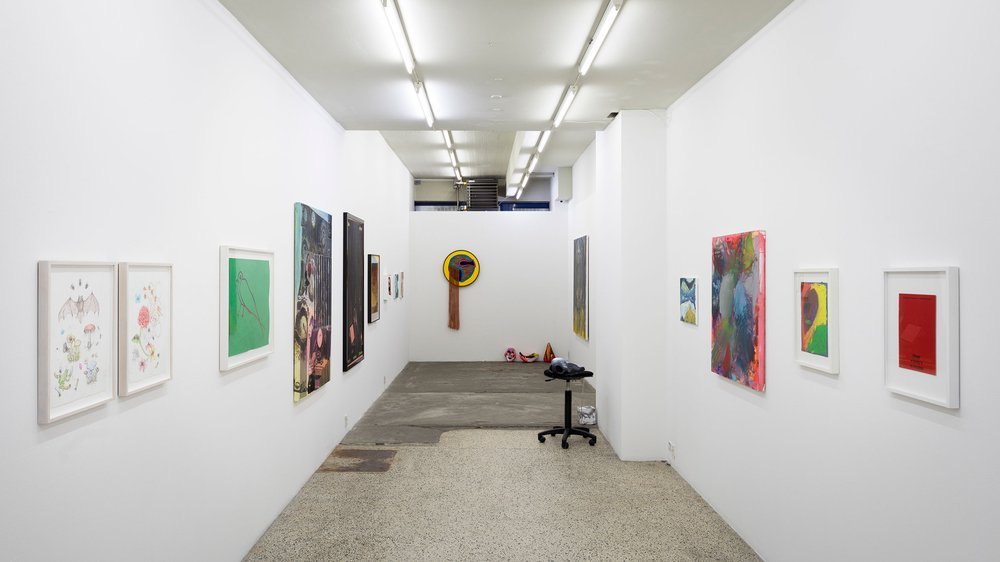Speaking in riddles with paint and portrait with artist Erik Formoe
*Archive Article: Originally published in the magazine Blacklisted Copenhagen on October 10, 2018
Web: erikformoe.com
I often come across a reoccurring theme when speaking with “artists” who are classically trained in their craft. And by that, I mean, people that have learned the fundaments of their trade before learning how to use it to express themselves. Unlike artists that just “create” without any formal training, classically trained artists–whether they be musicians, performers, writer, painters, or poets–often need to go through this period of training themselves to “break” their training.
To quote the American poet Marvin Bell, “Learn the rules, break the rules, make up new rules, break the new rules.” It’s a wonderful sentiment, but often far more difficult than it might sound. To give an example, if one spends 20 years training in ballet, then begins to shift their artistic focus from dancer to choreographer–that classic training can become more of a crutch than a blessing. Artistic individuality springs from personal creative development, not the replication of another’s creative development.
In my opinion, this rings true in any form of creativity. I feel this is why many artists that are self-taught often have a head start in developing their own artistic path–contrary to what might be assumed. Do you think the Sex Pistols would have created a sound as they did, had they all been classically trained jazz musicians? Unlikely.
In my opinion, it’s a falsehood to assume that because you learn to paint, you will have the tools to be a good artist. This is true only if when one learns how to control the rules, and not be dictated by them.
In the case of Norwegian artist Erik Formoe, this is exactly what he has done. Beyond the expression that he has developed in his modern symbolist portraits, one can see his training. But one can also see his mastery of it.
His works are in some way reminiscent of artists like Gustav Klimt and Odilon Redon, but in many ways…not. You can see his understanding of the specific painting techniques and methods but used in the form of his own personal expression.
Formoe is a self-proclaimed “riddle-teller,” in the way he describes his work. This struck me as an interesting concept in relation to his portraits, so I reached out to him learn a little bit more about his work, and find out how he shaped his classic training into the unique work that he now creates.
INTERVIEW
To start with, tell me a little bit about how you’ve developed your style?
As a young man, I was taken by the French impressionists- Cezanne, Monet, and Manet were the lead. They added something new when they went outdoors and painted just in front of their motivation. This added a freshness that had not been present before.
Monet painted loose by adding brush strokes into points. Furthermore, he made the colors blend optically to the eye. The painting became an intense abstract surface when you looked closely. This fascinated me, and I started painting like the Impressionists.
The problem in Norway is the changing weather. In southern Europe, it will remain stable for several days. It became easier to get back to the subject and work several days with the same painting. The advantage of painting outdoors in daylight is that the colors become more intense. You get vibrating color expressions that appealed to me.
When I started at the Oslo Academy of Arts, it was mandatory to paint from a model. Working more with lines and shapes made it harder to maintain free brushing. The colors were, therefore, darker and more neutral. The main emphasis was put in shape. However, the theme of combining looser painting methods with strict form became an interesting topic for me at the time. This theme has followed me for almost 40 years and is the main reason my paintings have evolved into what they are now.
You describe yourself as a “riddle teller.” Can you elaborate on what this means in the context of how to create?
For many years, I’ve painted portraits or groups of people as a theme. The portraits are not specific people, but people we meet every day everywhere. My thought is that all people have a story to tell. We don’t know those we meet on the street, and we have to form our own image of the ones we see. Thus, I let the audience imagine freely from the little clues I give. Thus, it will not be the same story for all.
As paintings are a dialogue between the image and the individual who sees it, it is about how much information, I as an artist, wish to give to the audience. I add geometric shapes, different headgear or I remove an eye or a mouth. Thus, I develop something mysterious and inexplicable. I disturb the eyes of those who look at the painting.
Such an approach gives me peculiar freedom as well. I can add shapes and colors because the painting does not make a truth. In this way, I become a “riddle teller”.
Your work blends more traditional techniques with almost “graphical” elements, what inspirations have led you to juxtapose these two aesthetic approaches together?
I am in many ways a classically educated artist. Remember, I was anxious to learn about artists from the early Italian Renaissance. We prepared canvases and wooden boards as they did before. At school, we had to acquire knowledge of many different techniques and materials such as tempera and fresco. There were no computers at the time, so all the focus was on good craftsmanship.
Furthermore, we worked a lot with the analysis of older paintings. We tried to figure out line patterns, and how artists used circles in perspective to create an illusion of depth. When I saw how Paul Cezanne continued this knowledge in his much more modern paintings, I became very interested in this theme. Therefore, I have always had the urge to build my compositions in harmony, as the old masters did.
Harmony itself becomes quickly boring, but the combination of harmony in the composition with rough brush strokes and graphical shapes has always been an important element of my artistry. The graphical shapes I insert into the paintings point to the future and are my ties to the contemporary painting. The painting technique itself points back in time, linking me to the past. The interaction is important to me.
So take me through your process when you begin a piece?
The way I start a painting has changed over the years.
In the past, I worked very intuitively and I started a painting to create chaos on the canvas. In the process, I kept sticking to what I felt was interesting. After some time, I had to paint over parts that I thought would be there in the end. I could keep on endlessly making changes, and eventually, I had trouble finishing the painting. I spent too much time on each piece, which caused a sense of inadequacy.
Recently I have begun planning much more. I take some photos of the subject I want to paint and make a composition in a computer program. At this stage, I end up with a light sketch in black and white. However, the composition is dictated, and I transfer it to the canvas as an undercoat or line drawing.
On the canvas, I add colors and break down the shapes. I can paint thick colors in expressive strokes, or thinner colors in many layers. I slowly build a color palette that appeals to me. In this way, I work a bit more controlled than I did before.
Your career as an artist pre-dates social media, so how do feel platforms like Instagram and Facebook have changed the artistic landscape and the way that contemporary artists like yourself further their careers?
I experienced early that computers could be an important help in developing myself as an artist. In the early 80´s I bought an Atari with 16 colors and no memory at all. At that time, floppy disks were used, and I had one with a drawing program called Degas. I was soon hooked on this new technology and bought more powerful computers by and by.
Already in the 90’s, I created my own website, which was unusual at the time. The internet connection was very slow so the photos could not be larger than 500 pixels. I remember it was a big article in the local newspaper that described how my art now spread throughout the world.
Eventually, Facebook came, and it was necessary to me for many years. It was a great way to spread the art. Now, however, Instagram works best for my part. Here, only the image is in focus, which suits me well.
I have attached very strong ties to social media, and it has led me to exhibitions in the Middle East as well as the United States and other Scandinavian countries.
Social Media has helped me show my art to a larger audience and has meant a lot to my career. At the same time, I have discovered so many amazingly good artists out there.
Are there aspects of media, pop culture, and current events influence your work or your thought-process in the studio?
Media means much the same as the art museums did before. The assortment of art has grown and is easier to access. Still, it means much to see art in reality at a museum, but it has become easier to pick out what’s interesting, then to seek it out.
I love the contrast between hectic cities and secluded life in nature. We have a cabin in a wooded area without close neighbors, in neighboring Sweden. I travel there as often as I can. The cities inspire me, while nature helps me sort the impressions.
Give me an example of a time in your life where the choice of living a life as an artist was trying?
Being an artist is an everlasting period of ups and downs. It can be difficult for long periods, but suddenly it will turn into something positive. There may be several reasons for that. You can stagnate artistically, struggle with poor finances, or there may be crises in the close circle of friends and family.
It’s important to paint even if it’s difficult. All the struggle and mistakes you make on a canvas become an experience that can be used later. There is always a light at the end of the tunnel. At least, it’s my experience.
What does a typical artist workday look like for you?
I work structured. I begin working when my wife goes to work. Ends when my wife comes home. Often, I also work in the evening. During the weekends, I often get free and do other things, but I think about art all day. I like to work but at the same time I need distance and to be a stranger to my paintings. I need to be analytic and critical to see what to remove, possibly what to add to my work.
In addition to painting, can you tell me about some other of your passions?
Regarding art, I have worked a lot with different graphic techniques. I also like working with photography.
If we go beyond the arts, I have had a period of training and running the marathon. That period is now over, but I like working in the woods. Felling trees, cutting them up and saving them for the winter gives me great satisfaction. You stay in shape, and the job is a bit lonely so you can think a lot.










